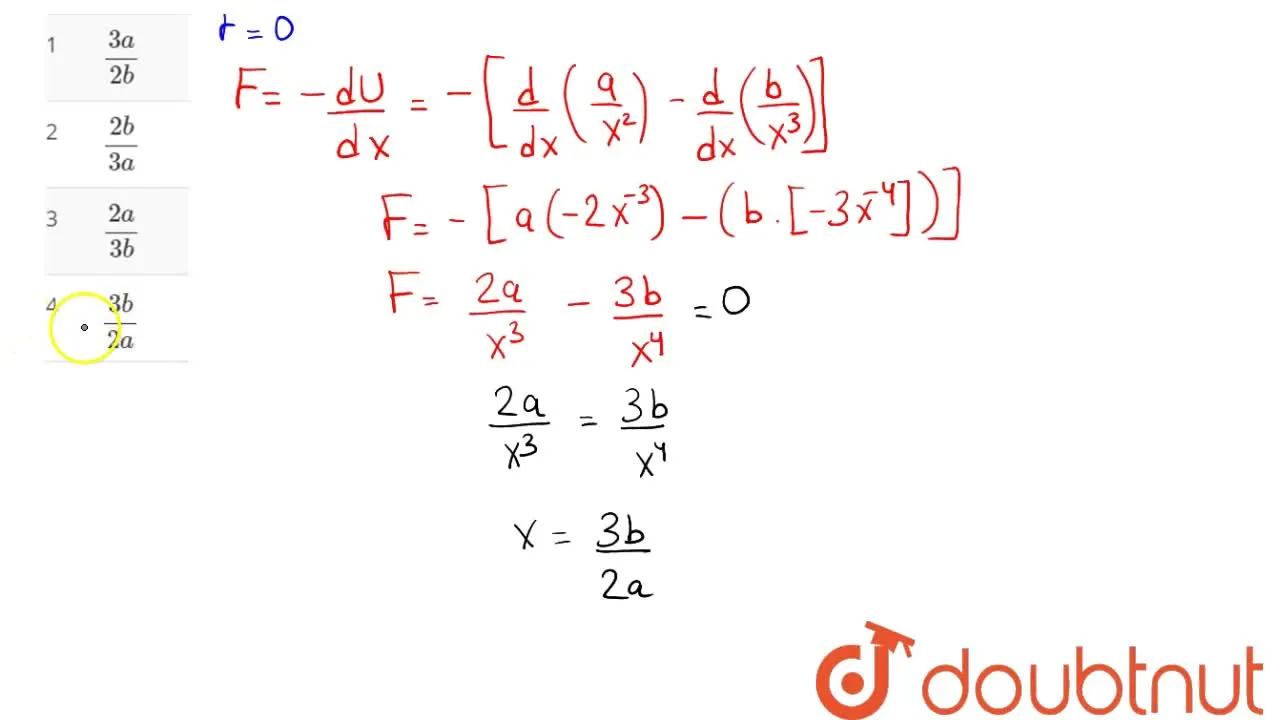A particle located in one dimensional potential field has potential energy functionU(x)=ax2−bx3, where a and b are positive constants. The position of equilibrium corresponds to x equal to
3a2b
2b3a
2a3b
3b2a
The correct Answer is:D
Step by step video & image solution for A particle located in one dimensional potential field has potential energy functionU(x)=(a)/(x^(2))-(b)/(x^(3)), where a and b are positive constants. The position of equilibrium corresponds to x equal to by Physics experts to help you in doubts & scoring excellent marks in Class 12 exams.
Related Playlists
- BOOK - AAKASH INSTITUTE ENGLISHCHAPTER - WORK, ENERGY AND POWEREXERCISE - Assignment (SECTION - C)80videos
WORK, ENERGY AND POWER
- BOOK - AAKASH INSTITUTE ENGLISHCHAPTER - WORK, ENERGY AND POWEREXERCISE - Assignment (SECTION - D)13videos
WORK, ENERGY AND POWER
- BOOK - AAKASH INSTITUTE ENGLISHCHAPTER - WORK, ENERGY AND POWEREXERCISE - Assignment (SECTION - A)64videos
WORK, ENERGY AND POWER
- BOOK - AAKASH INSTITUTE ENGLISHCHAPTER - WAVESEXERCISE - ASSIGNMENT ( SECTION-D ( Assertion - Reason Type Questions ))12videos
WAVES
Similar Questions
A particle located in a one-dimensional potential field has its potential energy function as U(x)ax4−bx2, where a and b are positive constants. The position of equilibrium x corresponds to
View SolutionA particle of mass m in a unidirectional potential field have potential energy U(x)=α+2βx2, where α and β are positive constants. Find its time period of oscillations.
View SolutionA partical of mass m is located in a unidimensionnal potential field where potentical energy of the partical depends on the coordinates xasU(x)=Ax2−Bx where A and B are positive constant.
Find the time period of small oscillation that the partical perform about equilibrium possition.View SolutionA particle of mass m is located in a region where its potential energy [U(x)] depends on the position x as potential Energy [U(x)]=ax2−bx here a and b are positive constants…
(i) Write dimensional formula of a and b
(ii) If the time perios of oscillation which is calculated from above formula is stated by a student as T=4πa√mab2, Check whether his answer is dimensionally correct.View SolutionA particle of mass m is located in a region where its potential energy [U(x)] depends on the position x as potential Energy [U(x)]=ax2−bx here a and b are positive constants…
(i) Write dimensional formula of a and b
(ii) If the time perios of oscillation which is calculated from above formula is stated by a student as T=4πa√mab2, Check whether his answer is dimensionally correct.View SolutionA particle of mass m moves in a one dimensional potential energy U(x)=−ax2+bx4, where a and b are positive constant. The angular frequency of small oscillation about the minima of the potential energy is equal to
View SolutionA particle of mass m is moving in a potential well, for which the potential energy is given by U(x)=U0(1−cosax) where U0 and a are positive constants. Then (for the small value of x)
View SolutionThe potential energy of a particle of mass 'm' situated in a unidimensional potential field varies as U(x)=U0[1−cos(ax2)], where U0 and a are positive constant. The time period of small oscillations of the particle about the mean position-
View SolutionIf P.E. of a system is given by relation U=Ax2−Bx, where 'A'and'B' are positive constant, then the mean positive of S.H.M.is
View SolutionThe potential energy of a particle in a certain field has the form U=(a/r2)−(b/r) , where a and b are positive constants and r is the distance from the centre of the field. Find the value of r0 corresponding to the equilibrium position of the particle, examine whether this position is stable.
View Solution


